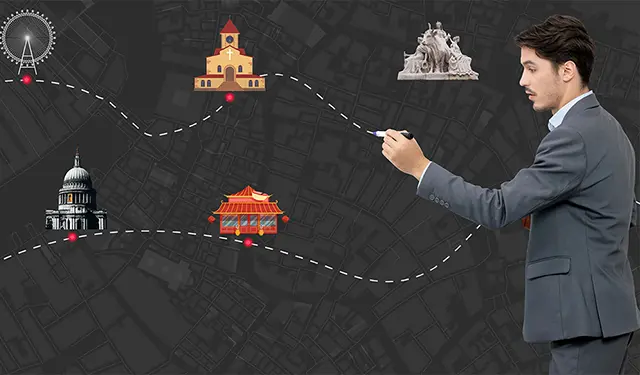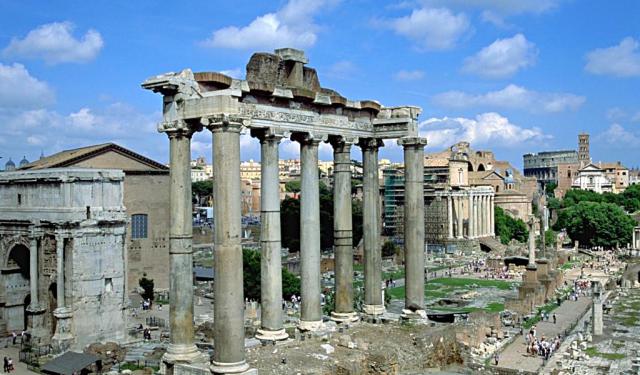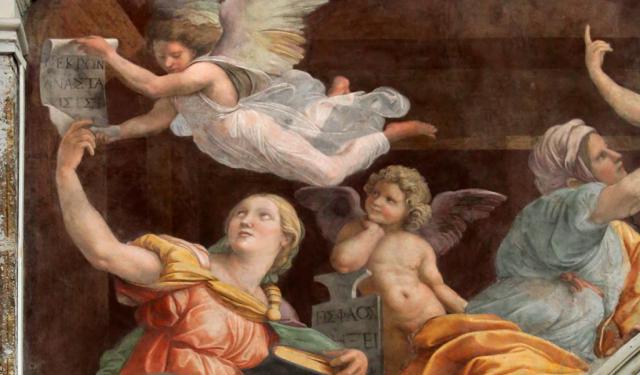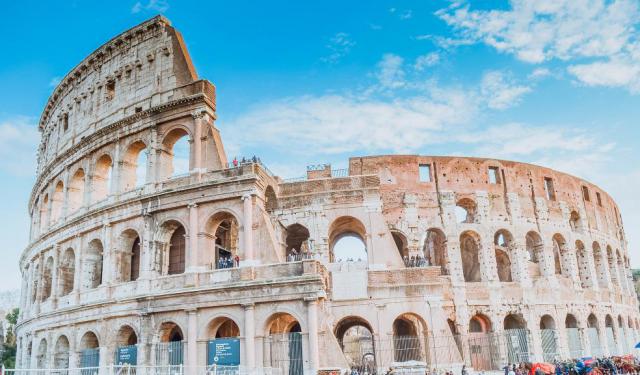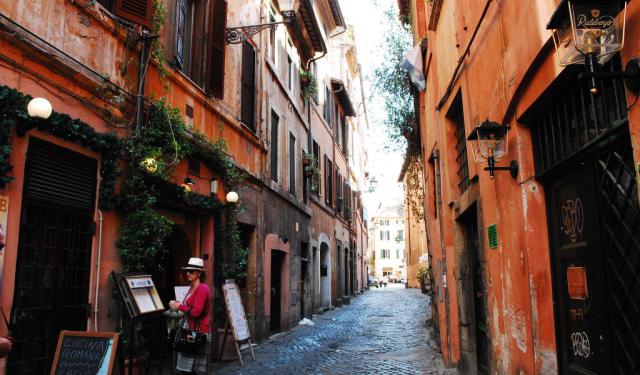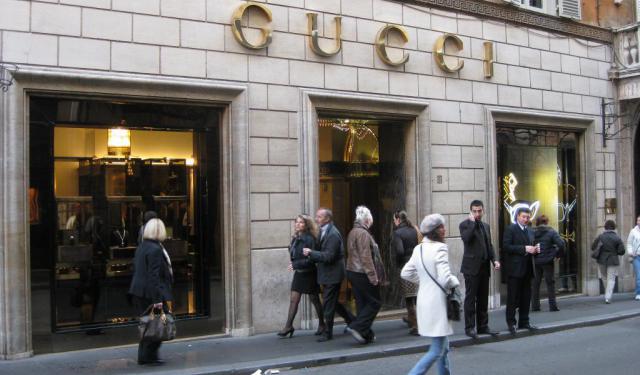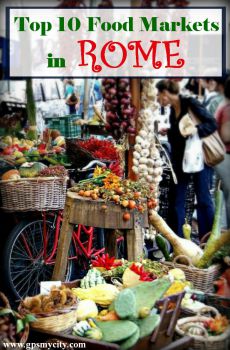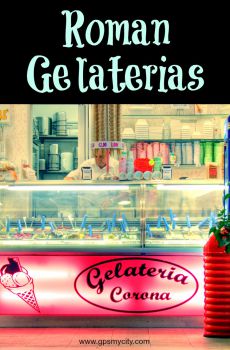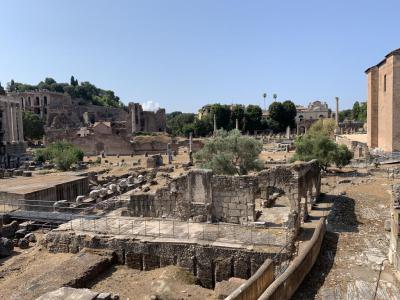
Foro di Nerva (Forum of Nerva), Rome
Roman Emperor Nerva, who reigned from 96 to 98 AD, is best known for initiating the Nerva-Antonine dynasty, a period of relative peace and prosperity in the Roman Empire. He came to power after the assassination of Emperor Domitian and was recognized for his efforts to restore stability to the empire following Domitian's autocratic rule.
Nerva is also famous for adopting Trajan, who later became his successor, thus securing the empire's future leadership and setting a precedent for the adoption of capable heirs rather than relying on biological descent. Nerva was the first of the so-called "Five Good Emperors", followed by Trajan, Hadrian, Antoninus Pius, and Marcus Aurelius, who ruled successively from 96 to 180 AD. His brief reign is often seen as a time of reform, focusing on social welfare, land distribution to the poor, and easing the harshness of previous administrations.
The construction of what's known as the Forum of Nerva was initiated by his predecessor, Emperor Domitian, before the year 85 AD. But it was officially completed and inaugurated 12 years later by Nerva, hence its name. This forum was the fourth and smallest of the imperial forums. It replaced the former Argiletum street, which had served as a market area, mainly for booksellers and cobblers. The new forum continued to function as both a thoroughfare and a grand entrance to the larger Roman Forum.
After the decline and fall of the Western Roman Empire, the area fell into disuse and became marshland. In the 9th century, several houses were constructed on the site, using materials salvaged from the ruins. The onsite Temple of Minerva remained relatively intact until Pope Paul V ordered its demolition in 1606.
Today, only a portion of the columns known as Le Colonnacce survive along the side of the Minerva Temple. These Corinthian columns are situated just less than two meters away from the temple's wall. While the Forum of Nerva does not have the same scale or visibility as the Roman Forum or the Forum of Caesar, it is still a fascinating site for those exploring ancient Roman history.
Nerva is also famous for adopting Trajan, who later became his successor, thus securing the empire's future leadership and setting a precedent for the adoption of capable heirs rather than relying on biological descent. Nerva was the first of the so-called "Five Good Emperors", followed by Trajan, Hadrian, Antoninus Pius, and Marcus Aurelius, who ruled successively from 96 to 180 AD. His brief reign is often seen as a time of reform, focusing on social welfare, land distribution to the poor, and easing the harshness of previous administrations.
The construction of what's known as the Forum of Nerva was initiated by his predecessor, Emperor Domitian, before the year 85 AD. But it was officially completed and inaugurated 12 years later by Nerva, hence its name. This forum was the fourth and smallest of the imperial forums. It replaced the former Argiletum street, which had served as a market area, mainly for booksellers and cobblers. The new forum continued to function as both a thoroughfare and a grand entrance to the larger Roman Forum.
After the decline and fall of the Western Roman Empire, the area fell into disuse and became marshland. In the 9th century, several houses were constructed on the site, using materials salvaged from the ruins. The onsite Temple of Minerva remained relatively intact until Pope Paul V ordered its demolition in 1606.
Today, only a portion of the columns known as Le Colonnacce survive along the side of the Minerva Temple. These Corinthian columns are situated just less than two meters away from the temple's wall. While the Forum of Nerva does not have the same scale or visibility as the Roman Forum or the Forum of Caesar, it is still a fascinating site for those exploring ancient Roman history.
Want to visit this sight? Check out these Self-Guided Walking Tours in Rome. Alternatively, you can download the mobile app "GPSmyCity: Walks in 1K+ Cities" from Apple App Store or Google Play Store. The app turns your mobile device to a personal tour guide and it works offline, so no data plan is needed when traveling abroad.
Foro di Nerva (Forum of Nerva) on Map
Sight Name: Foro di Nerva (Forum of Nerva)
Sight Location: Rome, Italy (See walking tours in Rome)
Sight Type: Attraction/Landmark
Guide(s) Containing This Sight:
Sight Location: Rome, Italy (See walking tours in Rome)
Sight Type: Attraction/Landmark
Guide(s) Containing This Sight:
Walking Tours in Rome, Italy
Create Your Own Walk in Rome
Creating your own self-guided walk in Rome is easy and fun. Choose the city attractions that you want to see and a walk route map will be created just for you. You can even set your hotel as the start point of the walk.
Roman Forum and Imperial Forums Walking Tour
t's a known fact that Rome wasn't built in a day. But since it was built, the city has stood the test of time and become "eternal." A popular proverb says, "all roads lead to Rome," but very few realize that, inside Rome itself, all roads lead to the Forum.
Indeed, the central hub of ancient Rome, the Roman Forum and the Imperial Forums once served as the... view more
Tour Duration: 3 Hour(s)
Travel Distance: 2.6 Km or 1.6 Miles
Indeed, the central hub of ancient Rome, the Roman Forum and the Imperial Forums once served as the... view more
Tour Duration: 3 Hour(s)
Travel Distance: 2.6 Km or 1.6 Miles
Hidden Art Treasures in Rome
Rome is one of the world's top living museums, replete with some of the most iconic pieces of art on the face of the planet. Famous artists, such as Michelangelo, Caravaggio, Raphael, Bernini, to mention but a few, had lived and worked here and left indelible marks in the city.
Needless to say that the abundance of masterpieces makes Rome crowded with tourists anxious to see them, causing... view more
Tour Duration: 2 Hour(s)
Travel Distance: 3.2 Km or 2 Miles
Needless to say that the abundance of masterpieces makes Rome crowded with tourists anxious to see them, causing... view more
Tour Duration: 2 Hour(s)
Travel Distance: 3.2 Km or 2 Miles
Rome Introduction Walking Tour I
Often referred to as the Eternal City, Rome holds a unique place in the story of Western civilization. Its influence shaped European culture through language, governance, and monumental architecture.
The name “Rome” originates from Romulus, the mythical founder of the city, who, according to legend, was the son of the war god Mars and Rhea Silvia, the priestess of goddess Vesta. Both,... view more
Tour Duration: 2 Hour(s)
Travel Distance: 3.3 Km or 2.1 Miles
The name “Rome” originates from Romulus, the mythical founder of the city, who, according to legend, was the son of the war god Mars and Rhea Silvia, the priestess of goddess Vesta. Both,... view more
Tour Duration: 2 Hour(s)
Travel Distance: 3.3 Km or 2.1 Miles
Trastevere Walking Tour
Heading down from the Vatican along the River Tiber, one is bound to find yet another city hidden within the city – Trastevere. This name translates literally to "across the Tiber". Indeed, crossing the picturesque Ponte Sisto (Sisto Bridge) to the west bank, you will find yourself in a charming neighborhood with a distinct character that sets it apart from any other part of Rome.
... view more
Tour Duration: 2 Hour(s)
Travel Distance: 2.9 Km or 1.8 Miles
... view more
Tour Duration: 2 Hour(s)
Travel Distance: 2.9 Km or 1.8 Miles
Rome Introduction Walking Tour II
Rome, the Eternal City, carries a legacy shaped by centuries of resilience, transformation, and cultural flourishing. The fall of the Roman Empire in 476 AD marked the end of an era, plunging Western Europe into the dark Middle Ages. Yet, even amid the disarray, Rome endured as a beacon of unity, largely due to its status as the center of Catholicism. The papacy wielded spiritual influence,... view more
Tour Duration: 2 Hour(s)
Travel Distance: 3.4 Km or 2.1 Miles
Tour Duration: 2 Hour(s)
Travel Distance: 3.4 Km or 2.1 Miles
Rome Shopping Streets Walking Tour
Loved by tourists for its busy fashionable streets and significant baroque icons, the so-called ‘Tridente’ is one of the Eternal City's most lusted-after areas, formed by Via dei Condotti, Via Borgognona, Via Frattina and the adjacent Via del Corso. It is perhaps the most high-end destination for Roman shopping, with a concentration of renowned jewelers and important Italian/international... view more
Tour Duration: 2 Hour(s)
Travel Distance: 2.9 Km or 1.8 Miles
Tour Duration: 2 Hour(s)
Travel Distance: 2.9 Km or 1.8 Miles
Useful Travel Guides for Planning Your Trip
10 Best Food Markets in Rome Italy
Of all the things Italy is most famous for (cars, music, fashion, movies, etc.), food is, undoubtedly, top of the list. Rome may well not be the whole Italy, but no Italy is whole without Rome... And the Romans, much as all their fellow-Italians, like it "fresco", hence the abundance of...
17 Best Gelaterias in Rome Italy
For ice cream lovers and dabblers this guide is a treasure chest of Rome’s best gelato shops. There are gelaterias everywhere. Many visitors to Rome only have a few days to explore the city. You owe it to yourself to make the most of your time and find the gelato locals eat. Often the authentic...
Souvenirs Shopping: 15 Authentic Italian Things To Buy in Rome
Rome is the Eternal City and, as such, the list of gift options available here is countless. Whether it's something edible, drinkable, wearable or pleasing to the eye that you want - you will find it all here in abundance. However, if time or budget is the factor, perhaps you might want to...
